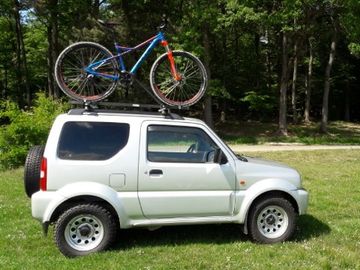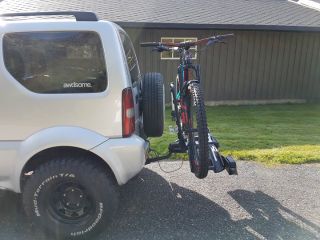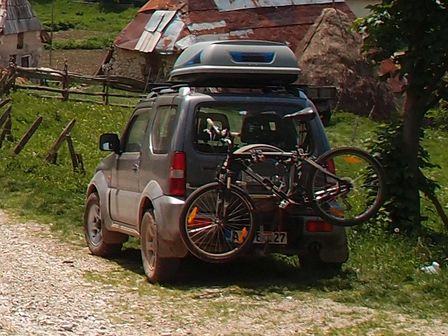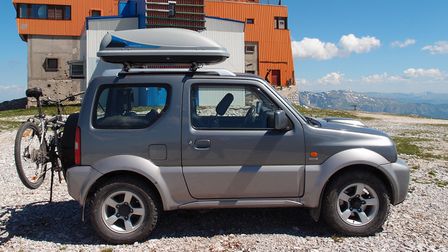![]() The content of any article might be expanded / improved in the future - revisit it sometimes.
The content of any article might be expanded / improved in the future - revisit it sometimes.
![]() Seen a mistake? Know something that isn't written? Edit and change this article yourself!
Seen a mistake? Know something that isn't written? Edit and change this article yourself!
![]() Some images in the article (if present) can be enlarged by clicking on them.
Some images in the article (if present) can be enlarged by clicking on them.
Contents
Introduction
Jimny has a specific "classic Jeep style" body, with completely vertical rear door and a rear door mounted spare wheel. This results in some specific possibilities and restrictions regarding the use of bicycle carriers.
You can use three types of bicycle carriers on a Jimny:
- Roof mounted
- Spare wheel mounted
- Tow bar mounted
There is one more type of bicycle carriers - rear door mounted - but that type can not be used on vehicles which have rear door mounted spare wheel (the wheel interferes).
![]() The wiki article "Accessories for Jimny (genuine Suzuki)" contains vast info and details on all known OEM Jimny accessories, including "Suzuki branded" roof mounted and tow bar mounted bicycle carriers which are officially recommended for use on Jimnys.
The wiki article "Accessories for Jimny (genuine Suzuki)" contains vast info and details on all known OEM Jimny accessories, including "Suzuki branded" roof mounted and tow bar mounted bicycle carriers which are officially recommended for use on Jimnys.
![]() If you intend to drive on rough gravel roads or off road while carrying bicycles (on any kind of bicycle carrier), you should take additional considerations, precautions and frequent checks during driving.
If you intend to drive on rough gravel roads or off road while carrying bicycles (on any kind of bicycle carrier), you should take additional considerations, precautions and frequent checks during driving.
Secure the bicycles or carriers with some additional straps.
Don't load the carriers, roof rails, spare wheel or tow bar near their weight load limit.
Stop occasionally and check if everything is still tightly screwed and tightly strapped.
You would be surprised what vibrations can do even to a tightly tightened system!
Roof mounted bicycle carriers
Introduction
Roof mounted bicycle carriers are quite popular for general vehicle usage, because of certain conveniences and because of no need to worry about any legal restrictions (in most cases).
However, they might not be the best option for a tall vehicle like Jimny.
Examples of roof mounted bicycle carriers are Thule 598 and Thule 532.
Advantages
- They mount on the same transverse roof racks on which you mount a cargo box, ski carriers, ladders, whatever.
- They leave the rear of the vehicle free, so you can open the rear door all the time, or tow a trailer or carry a tow bar mounted cargo box.
- One carrier carries one bicycle. So you can install any number between 1 and 4 on the roof. If you have a roof box or a pair of ski carriers, you can have one or possibly two bicycle carriers besides it on the roof at the same time.
- Roof mounted bicycles do not "stick" out from the sides of the car as they do with rear-mounted carriers.
- You can keep the carriers on the roof all the time, as they are low profile and don't disturb anything. In other words, you don't have to dismount and mount them every time you go out with bicycles.
- Most of them can be locked to the roof rails with some "keylock" system, requiring a thief to damage the carrier in order to dismount it. This enables you to safely leave the car in the open with the roof bicycle carriers mounted while you are on a bike ride.
Disadvantages
- Can not be used on Jimnys which can not have transverse roof racks (all cabrio Jimnys and some closed cabin Jimnys).
- Most expensive considering that they prerequisite transverse roof racks, and each bicycle carrier (which isn't cheap) carries only one bicycle.
- They additionally increase the center of gravity of an already tall narrow vehicle.
- The vehicle is very tall with the mounted bicycles, restricting access to most closed garages, and requiring caution when going under or near trees.
- It is quite difficult to mount and dismount the bicycles on Jimny's rather tall roof. Perform a small test - lift a bicycle onto the vehicle's roof and see for yourself. The actual bicycle carrier will sit even 10-15 cm higher than the height of the roof.
- Risk of damaging the vehicle's body or a bicycle if it slips out or drops off your hands when you are mounting it or dismounting it.
- Air resistance increase is the highest with roof mounted bicycles.
Spare wheel mounted bicycle carriers
Introduction
This kind of bicycle carriers is specifically made for all-terrain vehicles which hare vertical rear door and a rear door mounted spare wheel. Those are vehicle models like Suzuki Samurai, Suzuki Jimny, Suzuki Vitara (1st, 2nd and 3rd gen.), Daihatsu Rocky / Fourtrak, Daihatsu Feroza, Nissan Terrano I and II, Nissan Patrol (most generations), Mitsubishi Pajero, various Land Rover Defenders, Discoveries and Range Rovers (depending on editions), various Toyota Land Cruisers (depending on edition), Jeep Wrangler, Jeep Liberty, Mercedes G-wagen, etc.
Some "crossover" vehicles are compatible as well, like Daihatsu Terios 1 & 2, Toyota Rav4 (1, 2 & 3), Honda CR-V 1 & 2, Land Rover Freelander 1, Volkswagen Touareg (depending on edition), etc.
Beware that the horizontal position of a spare wheel on the rear door is typically not centered in most vehicles. The horizontal position can vary significantly from one vehicle model to another.
Therefore, a certain spare wheel mounted bicycle carrier might be designed for only a certain horizontal position of the spare wheel. When purchasing a spare wheel mounted bicycle carrier, you should double-check if the mounted bicycles would be properly horizontally centered in relation to the transverse contours of the vehicle. If not, the mounted bicycle(s) will stick out excessively from one side of the vehicle!
Variants
There are two general designs for spare wheel mounted bicycle carriers:
- Platform style, where the bicycles sit on a platform below them. The platform has an "L" shape.
- Pendant style, where the bicycles hang on their middle crossframe (between the saddle and the steering frame) on the carrier.
An example of platform-type spare wheel mounted bicycle carrier is Peruzzo Brennero.
An example of pendant-type spare wheel mounted bicycle carrier is Peruzzo 4x4 Bike Carrier 30.
Advantages
- Vehicle height is not changed (center of gravity, access to closed garages and under trees).
- Bicycles are relatively easy to mount and dismount on the carrier (no need for high "above-the-head" lifting, but still slightly higher than with tow bar mounted bicycle carriers).
- Bicycles have minimal or no chances of contact with the vehicle during mounting or dismounting, therefore minimizing or eliminating the risk of vehicle's paint damage.
- The roof remains free to use a roof mounted cargo box for example.
- Tow bar remains free to attach a trailer.
- They add weight to the rear of the vehicle, which is always beneficial for a Jimny.
- Rear door can be opened while the carrier is mounted (with most carrier models), but typically no bicycle must be present on the carrier.
- Some models can be folded on the spare tyre when no bicycles are present, so you can drive around with a mounted and empty spare wheel bicycle carrier without looking awkward. This reduces the frequency of having to mount and dismount the bicycle carrier.
- Some models can also carry skis in vertical position with installation of an accessory adapter.
- Least expensive, especially considering that they don't have any prerequisites like roof racks or a tow bar.
Disadvantages
- A spare wheel cover has to be removed.
- With most carrier models, a spare rim cover has to be removed as well.
- They add significant weight to the rear door, as the rear door solely carries the spare tyre. There is a risk of damaging the rear door hinges, especially if the bicycles are carried on undulated gravel roads or off road!
- Most models can carry 2 bicycles at most.
- The law might require the use of an additional license plate and brake+turn lights on the bicycle carrier.
- They extend the length of the vehicle slightly. However Jimny is so short that this should not be a major issue.
- Mounted bicycles "stick" out from one or both sides of the vehicle, essentially significantly widening the vehicle. However the total width would rarely exceed the width of a typical van, like a Volkswagen Transporter.
- Most designs do not have any kind of "keylock" system to the spare wheel, enabling a thief to dismount the carrier with bare hands or common tools. This implies that it might be risky to leave the car in the open with a spare wheel bicycle carrier mounted while you are on a bike ride.
Tow bar mounted bicycle carriers
Introduction
Tow bar mounted bicycle carriers are generally a very convenient option for vehicles which have a tow bar. It might even pay off to buy and install a tow bar just for the purpose of being able to use a tow bar mounted bicycle carrier.
However, there are certain restrictions and issues when using tow bar mounted bicycle carriers with vehicles which have "classic Jeep style" body, like the Jimny.
![]() The wiki article "Tow bar" contains all information about installing and using tow bar on a Jimny.
The wiki article "Tow bar" contains all information about installing and using tow bar on a Jimny.
![]() Beware that the load limit for most vehicle tow balls is in the range of 50 - 75 kg! You must count in the weight of a bicycle carrier together with the bicycles when doing the weight calculation.
Beware that the load limit for most vehicle tow balls is in the range of 50 - 75 kg! You must count in the weight of a bicycle carrier together with the bicycles when doing the weight calculation.
Variants
There are two general types of tow bar mounted bicycle carriers:
- Platform style, where the bicycles sit on a platform below them. The platform has an "L" shape, and is connected to the tow ball.
- Pendant style, where the bicycles hang on their middle crossframe (between the saddle and the steering frame) on the carrier. The carrier is mounted on the tow ball and immediately goes upwards, and then straight on like vertically inversed "L" shape.
- A Jimny carrying a tow hook mounted, platform style bicycle carrier for two bicycles (Thule Velocompact 2) with one bicycle on it
- A Jimny carrying a tow hook mounted, pendant style bicycle carrier for two bicycles (Peruzzo Cruising) with one bicycle on it
- An example of a platform tow bar mounted bicycle carrier is "Thule 929"
- An example of a pendant tow bar mounted bicycle carrier is "Thule 9708".
Advantages
- Vehicle height is not changed (center of gravity, access to closed garages and under trees).
- Bicycles are quite easy to mount and dismount on the carrier (no need for high lifting at all, especially with platform-type tow bar mounted bicycle carriers).
- Bicycles have minimal or no chances of contact with the vehicle during mounting or dismounting, therefore minimizing or eliminating the risk of vehicle's paint damage.
- One carrier can carry between 1 and 4 bicycles (depending on a model).
- The roof remains free to use a roof mounted cargo box for example.
- They are typically relatively simple to mount on the tow ball (model specific).
- Tow bar is the best point of the vehicle to carry a load.
- They add weight to the rear of the vehicle, which is always beneficial for a Jimny.
- Pendant-type tow bar mounted bicycle carriers are a very economical and practical option, especially if the vehicle already has a tow bar.
Disadvantages
- They prerequisite the presence of a tow bar (which is not bad to have anyway, see wiki article "Tow bar").
- They block the rear door, so you can not open the rear door while the carrier is mounted, even if no bicycles are present. You can not open the door even if the carrier is a tiltable design, because no matter how much you tilt it away, it won't provide more than a couple of inches of space to open the door. The spare tyre is the main cause of the lack of maneuverability.
- The law might require the use of an additional license plate and brake+turn lights on the bicycle carrier.
- Some designs do not have any kind of "keylock" system to the tow bar, enabling a thief to dismount the carrier with bare hands or common tools. This implies that it might be risky to leave the car in the open with a tow bar bicycle carrier mounted while you are on a bike ride.
- Some models (commonly platform-type ones) can not be folded when no bicycles are present. Driving around with such a mounted and empty tow bar bicycle carrier might be awkward, so it typically needs to be dismounted if you don't use it.
- They extend the length of the vehicle. However Jimny is so short that this should not be a major issue.
- Mounted bicycles will probably "stick" out from one or both sides of the vehicle, essentially significantly widening the vehicle. In reality, the total width would rarely exceed the width of a typical van, like a Volkswagen Transporter. However, the law in some countries prohibits carrying an externally mounted cargo on a vehicle, where the cargo is wider (protrudes more sideways) than either of the external side mirrors. Beware of this before you embark on a travel and check with the authorities.
- Platform-type tow bar mounted bicycle carriers are bulky and quite heavy. They can not be stowed away in the vehicle when dismounted.
- Platform-type tow bar mounted bicycle carriers are typically very expensive.
- With Jimnys, pendant-type tow bar mounted bicycle carriers can be used only if the tow neck (tow ball section) is longer than the rear door mounted spare wheel, so that the tow ball protrudes longer below the spare wheel. Otherwise, you can not mount the bicycle carrier vertically, and that can be a significant issue depending on the design of the bicycle carrier. Platform mounted tow bar bicycle carriers typically do not have a problem if the tow neck is shorter than the spare wheel.
If your tow ball is just a tad shorter than needed to be able to mount your pendant-style tow bar mounted bicycle carrier straight upwards (without colliding with the spare wheel), you might be able to remedy the situation by changing all five tyres to a narrower profile (for example 195 / 80 / R15).
See the wiki article "Tyre selection and usage - best practices" for more info.
Page last edited on 21/02/2019 by user Bosanek







